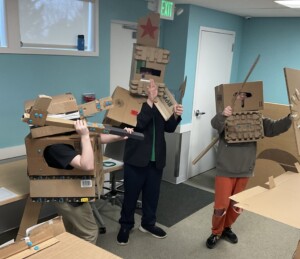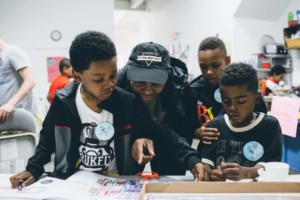No More Cookie-Cutter Schools

As you walk through the halls of Carl Wunsche Senior High School in Houston you can almost hear the voices of facility planners navigating you through a new high school experience. In this career academy, large open classrooms are filled with robotics equipment, engineering labs, and crime scene investigations. The nearby veterinary classroom is accepting patients and court is being held in the lifesize courtroom where legal students meet. Above the open classrooms, students fill math, English and history classes overlooking where their labs will take place later in the day.
As you pass the threshold of each academy into the next you know you’ve entered a school with a new focus. Preschool students are greeted with snacks by their high school leaders, and students perform maintenance on laptops in the student led computer repair office. The smells of French pastries fill the air as culinary students prep the day’s lunch. This isn’t a cookie-cutter high school – it’s a next generation learning environment designed by school leaders and architect Frank S. Kelly.
In Teaching the Digital Generation, Kelly joins authors Ted McCain and Ian Jukes to provide a resource that enables leaders to combine facilities and curriculum planning to create next-generation schools. Next-generation schools are not just about new types of curriculum and technology, they require incorporating facility design into the school vision.
“Conventional wisdom is that it takes great strength to hold on to something. In my view, it takes the greatest strength to let go of something you have done the same way for a long time,” says Ted McCain.
The authors argue that students have moved into the information age, yet our schools are still in the industrial age. Most high schools in America are only graduating two thirds of their students, and in some areas that number is less than half. With the increase in available information and technology, the ways students learn and process information has dramatically changed. In order for our students to compete for jobs both domestically and internationally we have to change not just what they learn, but where they learn.
The authors outline some of the main learning preferences of today’s learners. They prefer:
- Receiving information quickly from multiple multimedia sources
- Parallel processing and multitasking
- Active, engaged learning
- Processing pictures, sounds and videos before text
- Random access to hyperlinked multimedia information
- Networking opportunities
Many preferences of which traditional high school classrooms are not offering. Meeting these learning preferences will require a significant shift in instructional practices. The authors also discuss the connection between instruction and the outside world. As readily apparent at Wunsche, access to experts in a student’s field of study is a critical learning component. Through internships, guest lecturers and mentors, students develop relationships and career readiness skills.
With all this in mind, changing the school design process is no easy feat. It requires a completely new set of questions and planning that most school leaders haven’t dealt with. The authors urge that bringing the right stakeholders to the design table (including students, parents, teachers, district staff and community members) and asking the right type of questions is a good place to start. With learning outcomes in mind, visioning exercises of what the school environment will be, can be more successful.
The vision questions the authors provide would be useful for facility planning discussions in any district. They encourage bringing all types of school leaders and stakeholders to the planning table. New school environments created with learning outcomes in mind will be flexible and will adapt as learning demands change.
Once key questions have been answered, the authors lead readers through a discussion of school models that can help begin the visualization process of the building and roles teachers and students will play. School examples from around the country help illustrate the success of these new school models. They bring the facilities planning discussion to life. The authors outline the following school model types:
- Academies
- Instructional centers
- Academic focus
- Learning labs
- Self-directed learning
- Time–Less + More
- Individualized instruction
- Cyber schools
- Diverse learning communities
What’s clear is there is not one type of next-generation high school, this is not a one size fits all guide book. Whether you decide to go with an academy focus or instructional center, schools should be personalized to meet the desired learning outcomes for the learners they serve. Within a district many different school models can be present, creating a diverse network of options to meet the needs of any learner. This book doesn’t claim to be the only resource planning committees should use, rather it’s a starting place for discussions and vision setting.
What kind of school will your team create?
Visit nomorecookiecutterschools.com for more resources from the authors.
For more see:





Brian Silberberg
This academy sounds incredibly exciting and potentially game-changing in how it tailors the education experience to students. At Books That Grow we also understand that need, and our app provides a library of reading materials, all of which can be read across multiple reading levels, so a single classroom can accommodate the needs of each particular student simultaneously. See more at http://www.booksthatgrow.com/.
Adam Baumgartner
I struggle with notion that technology allows students to mufti-task at a higher efficiency. Now, there is no doubt that technology can enhance the learning environment in numerous ways. Just because students today can be engaged in multiple sources of technology at once does not mean that can read a read directions, interpret a question and utilize a rubric, in the same setting, any more effectively. In fact, I find that most students struggle with this. Multitasking technology does not necessarily equate to comprehension.